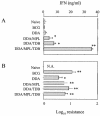Combination of the cationic surfactant dimethyl dioctadecyl ammonium bromide and synthetic mycobacterial cord factor as an efficient adjuvant for tuberculosis subunit vaccines
- PMID: 14977968
- PMCID: PMC356055
- DOI: 10.1128/IAI.72.3.1608-1617.2004
Combination of the cationic surfactant dimethyl dioctadecyl ammonium bromide and synthetic mycobacterial cord factor as an efficient adjuvant for tuberculosis subunit vaccines
Abstract
Recombinant, immunodominant antigens derived from Mycobacterium tuberculosis can be used to effectively vaccinate against subsequent infection. However, the efficacy of these recombinant proteins is dependent on the adjuvant used for their delivery. This problem affects many potential vaccines, not just those for tuberculosis, so the discovery of adjuvants that can promote the development of cell-mediated immunity is of great interest. We have previously shown that the combination of the cationic surfactant dimethyl dioctadecyl ammonium bromide and the immunomodulator modified lipid A synergistically potentiates Th1 T-cell responses. Here we report a screening program for other adjuvants with reported Th1-promoting activity and identify a second novel adjuvant formulation that drives the development of Th1 responses with an extremely high efficacy. The combination of dimethyl dioctadecyl ammonium bromide and the synthetic cord factor trehalose dibehenate promotes strong protective immune responses, without overt toxicity, against M. tuberculosis infection in a vaccination model and thus appears to be a very promising candidate for the development of human vaccines.
Figures



Similar articles
-
Adjuvant Potential of Poly-α-l-Glutamine from the Cell Wall of Mycobacterium tuberculosis.Infect Immun. 2018 Sep 21;86(10):e00537-18. doi: 10.1128/IAI.00537-18. Print 2018 Oct. Infect Immun. 2018. PMID: 30104212 Free PMC article.
-
Potentiation of Th1-Type Immune Responses to Mycobacterium tuberculosis Antigens in Mice by Cationic Liposomes Combined with De-O-Acylated Lipooligosaccharide.J Microbiol Biotechnol. 2018 Jan 28;28(1):136-144. doi: 10.4014/jmb.1709.09009. J Microbiol Biotechnol. 2018. PMID: 29081214
-
A novel liposome adjuvant DPC mediates Mycobacterium tuberculosis subunit vaccine well to induce cell-mediated immunity and high protective efficacy in mice.Vaccine. 2016 Mar 8;34(11):1370-8. doi: 10.1016/j.vaccine.2016.01.049. Epub 2016 Feb 2. Vaccine. 2016. PMID: 26845736
-
Potential of Cationic Liposomes as Adjuvants/Delivery Systems for Tuberculosis Subunit Vaccines.Rev Physiol Biochem Pharmacol. 2018;175:47-69. doi: 10.1007/112_2018_9. Rev Physiol Biochem Pharmacol. 2018. PMID: 29700609 Review.
-
Immunocorrelates of CAF family adjuvants.Semin Immunol. 2018 Oct;39:4-13. doi: 10.1016/j.smim.2018.10.003. Epub 2018 Nov 2. Semin Immunol. 2018. PMID: 30396811 Review.
Cited by
-
Syringe free vaccination with CAF01 Adjuvated Ag85B-ESAT-6 in Bioneedles provides strong and prolonged protection against tuberculosis.PLoS One. 2010 Nov 29;5(11):e15043. doi: 10.1371/journal.pone.0015043. PLoS One. 2010. PMID: 21124731 Free PMC article.
-
Adjuvant Potential of Poly-α-l-Glutamine from the Cell Wall of Mycobacterium tuberculosis.Infect Immun. 2018 Sep 21;86(10):e00537-18. doi: 10.1128/IAI.00537-18. Print 2018 Oct. Infect Immun. 2018. PMID: 30104212 Free PMC article.
-
The adjuvant mechanism of cationic dimethyldioctadecylammonium liposomes.Immunology. 2007 Jun;121(2):216-26. doi: 10.1111/j.1365-2567.2007.02560.x. Epub 2007 Feb 14. Immunology. 2007. PMID: 17302734 Free PMC article.
-
Chlamydia muridarum T-cell antigens formulated with the adjuvant DDA/TDB induce immunity against infection that correlates with a high frequency of gamma interferon (IFN-gamma)/tumor necrosis factor alpha and IFN-gamma/interleukin-17 double-positive CD4+ T cells.Infect Immun. 2010 May;78(5):2272-82. doi: 10.1128/IAI.01374-09. Epub 2010 Mar 15. Infect Immun. 2010. PMID: 20231405 Free PMC article.
-
Immunological Activity of Vaccine Systems Containing Liposomal Nanocarriers against Protozoan-induced Diseases: A Systematic Review.Curr Med Chem. 2025;32(18):3620-3637. doi: 10.2174/0109298673306158240620071438. Curr Med Chem. 2025. PMID: 38967082
References
-
- Abu-Amer, Y., and Z. Bar-Shavit. 1994. Modulation of vitamin D increased H2O2 production and MAC-2 expression in the bone marrow-derived macrophages by estrogen. Calcif. Tissue Int. 55:29-32. - PubMed
-
- Agger, E. M., and P. Andersen. 2001. Tuberculosis subunit vaccine development: on the role of interferon-gamma. Vaccine 19:2298-2302. - PubMed
-
- Andersen, P., A. B. Andersen, A. L. Sorensen, and S. Nagai. 1995. Recall of long-lived immunity to Mycobacterium tuberculosis infection in mice. J. Immunol. 154:3359-3372. - PubMed
Publication types
MeSH terms
Substances
LinkOut - more resources
Full Text Sources
Other Literature Sources

